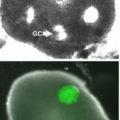
Photosynthesis’ amazingly efficient conversion of solar energy into chemical energy relies on sunlight being converted almost instantaneously, but how this speedy energy transfer actually happens has been a long-standing mystery. Now, researchers from Berkeley Lab say that quantum mechanical effects may be at the heart of the process.
Using femtosecond scale electronic spectroscopy measurements, the researchers detected “quantum beating” signals – coherent electronic oscillations in both donor and acceptor molecules – generated by light-induced energy excitations. They observed these oscillations meeting and interfering constructively, forming wavelike motions of energy (superposition states) that can explore all potential energy pathways simultaneously and reversibly, meaning they can retreat from wrong pathways with no penalty.
The new findings contradict the classical description of the photosynthetic energy transfer process as one in which excitation energy “hops” from light-capturing pigment molecules to reaction center molecules step-by-step down the molecular energy ladder. “The classical hopping description of the energy transfer process is both inadequate and inaccurate,” said Fleming. “It gives the wrong picture of how the process actually works, and misses a crucial aspect of the reason for the wonderful efficiency.”
Writing in Nature, the researchers described how they focused their attention on the Fenna-Matthews-Olson (FMO) photosynthetic light-harvesting protein. FMO is considered a model system for studying photosynthetic energy transfer because it consists of only seven pigment molecules and its chemistry has been well characterized.
“To observe the quantum beats, 2-D spectra were taken at 33 population times, ranging from 0 to 660 femtoseconds,” explained co-researcher Gregory Engel. “In these spectra, the lowest-energy exciton (a bound electron-hole pair formed when an incoming photon boosts an electron out of the valence energy band into the conduction band) gives rise to a diagonal peak near 825 nanometers that clearly oscillates. The associated cross-peak amplitude also appears to oscillate. Surprisingly, this quantum beating lasted the entire 660 femtoseconds.” The duration of the quantum beating signals was unexpected because the general scientific assumption had been that the electronic coherences responsible for such oscillations are rapidly destroyed.
“For this reason, the transfer of electronic coherence between excitons during relaxation has usually been ignored,” Engel added. “By demonstrating that the energy transfer process does involve electronic coherence and that this coherence is much stronger than we would ever have expected, we have shown that the process can be much more efficient than the classical view could explain.”
“Nature has had about 2.7 billion years to perfect photosynthesis, so there are huge lessons that remain for us to learn,” Engel concluded. “The results we’re reporting in this latest paper, however, at least give us a new way to think about the design of future artificial photosynthesis systems.”
Related:
Chemists Take Step Toward Artificial Photosynthesis
More about the research


















Comments are closed.